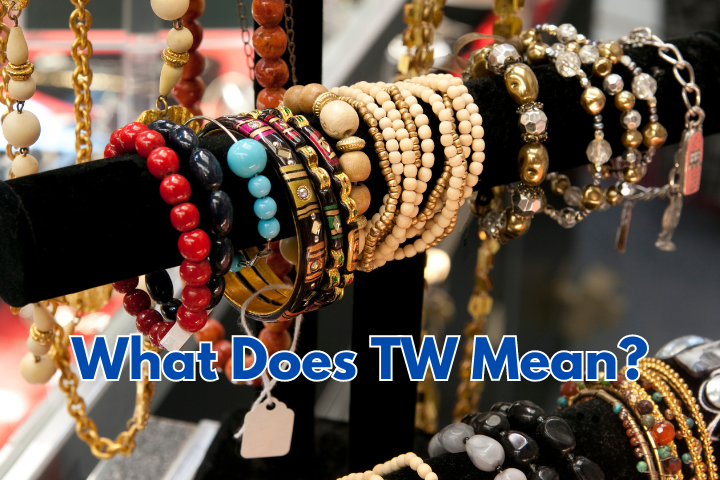When shopping for jewelry, you may have come across the abbreviation “TW” on price tags or product descriptions. But what does TW mean in jewelry?
In this comprehensive guide, we’ll explore the significance of this term and how it can help you make informed decisions when purchasing jewelry.
TW stands for “total weight” and is a crucial metric used in the jewelry industry to describe the overall weight of a piece of jewelry, particularly diamonds or other gemstones. This measurement is important because it provides a clear indication of the quantity and quality of the materials used in the creation of the jewelry item.
Understanding Total Weight (TW) in Jewelry
The total weight of a piece of jewelry is the combined weight of all the individual components, including the metal, gemstones, and any other materials used in its construction. This measurement is typically expressed in carats (ct) or grams (g), with one carat being equivalent to 0.2 grams.
For example, if a diamond ring has a total weight of 2 carats, it means that the combined weight of the diamond or diamonds in the ring is 2 carats. This information can be useful when comparing the value and quality of different jewelry pieces, as a higher total weight generally indicates a more substantial and valuable item.
What Does Alt Points Mean in Betting?
Factors That Influence Total Weight (TW)
Several factors can influence the total weight of a piece of jewelry, including:
- Gemstone size and quantity:
The size and number of gemstones used in a piece of jewelry will directly impact the total weight. Larger or more numerous gemstones will result in a higher TW. - Metal type and thickness:
The type of metal used (e.g., gold, silver, platinum) and the thickness of the metal components can also contribute to the overall weight of the jewelry. - Additional elements:
Any additional elements, such as clasps, chains, or settings, will also be factored into the total weight of the piece.
Importance of Understanding Total Weight (TW)
Knowing the total weight of a piece of jewelry is important for several reasons:
- Comparing value and quality:
The TW can help you assess the value and quality of a jewelry item, as a higher TW generally indicates a more substantial and valuable piece. - Budgeting and pricing:
Understanding the TW can assist you in budgeting for a jewelry purchase and negotiating a fair price. - Maintenance and care:
Knowing the TW can also help you determine the appropriate care and maintenance required for a piece of jewelry, as heavier items may need more specialized handling. - Resale and insurance:
If you ever need to resell or insure your jewelry, the TW information can be crucial in determining the item’s value and coverage.
Interpreting Total Weight (TW) Markings on Jewelry
When shopping for jewelry, you’ll often see the TW marked on the price tag or product description. This information is typically presented in the following formats:
- “TW 2.0 ct”:
This means the total weight of the jewelry item is 2.0 carats. - “TW 5 g”:
This indicates the total weight of the jewelry item is 5 grams.
It’s important to note that the TW marking refers to the combined weight of all the components, not just the weight of the primary gemstone or metal. This distinction is crucial when comparing the value and quality of different jewelry pieces.
Comparing Jewelry Pieces Based on Total Weight (TW)
When comparing the value and quality of various jewelry pieces, the TW can be a helpful metric to consider. Here are some tips for using TW to make informed decisions:
- Compare pieces with similar TW:
When evaluating different jewelry options, focus on comparing items with similar total weights. This will help you assess the relative value and quality of the pieces more accurately. - Consider the gemstone quality:
While TW is important, the quality of the gemstones used, such as their cut, clarity, and color, also plays a significant role in determining the overall value of the jewelry. - Factor in the metal type and quality:
The type and quality of the metal used in the jewelry can also impact its value. For example, a piece with a higher gold content or a more durable metal like platinum may be more valuable than a similar item with a lower-quality metal. - Seek professional appraisals:
For high-value or unique jewelry pieces, it’s always a good idea to seek the expertise of a professional appraiser. They can provide a detailed assessment of the item’s total weight, gemstone quality, and overall value.
Conclusion
Understanding the meaning of “TW” in jewelry is crucial for making informed purchasing decisions and ensuring you get the best value for your money.
By familiarizing yourself with the concept of total weight and how it relates to the quality and value of a jewelry item, you can navigate the jewelry market with confidence and find the perfect piece to suit your needs and budget.

